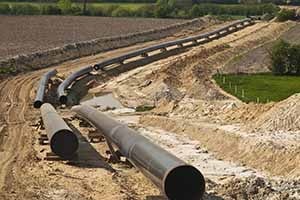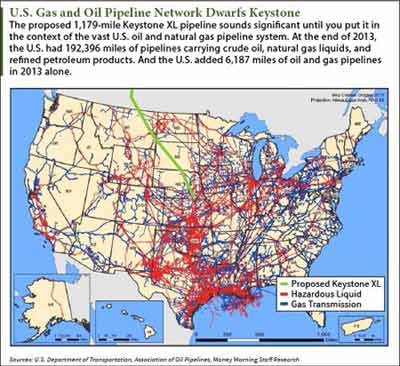 The fate of the Keystone XL pipeline got even cloudier yesterday (Monday) when TransCanada Corp. (NYSE: TRP), the company that wants to build it, asked the U.S. Department of State to suspend its permit application.
The fate of the Keystone XL pipeline got even cloudier yesterday (Monday) when TransCanada Corp. (NYSE: TRP), the company that wants to build it, asked the U.S. Department of State to suspend its permit application.
TransCanada needs a permit from the State Department because the Keystone pipeline crosses an international border. The company first applied for the permit in 2008.
The planned 1,179-mile pipeline would transport tar sands oil from Alberta, Canada to Nebraska, where it would connect with an existing pipeline. Ultimately, the Alberta oil would end up in U.S. Gulf Coast refineries.
In the United States, the Keystone oil pipeline has become a political battleground. Liberals have opposed it as damaging to the environment. Conservatives have supported it as a job-creating project that would contribute to the nation's energy independence.
Lately the liberals have been winning. A bill to approve the Keystone XL pipeline was defeated in the Senate in 2014. And after years of waffling on the issue, President Barack Obama has over the past year hinted that he would reject it following the completion of the State Department's review.
A negative recommendation from the State Department was expected as early as this week, according to The Wall Street Journal.
That may have prompted TransCanada to request the suspension. A long delay could postpone the decision until after the 2016 election - when a Keystone-friendly Republican might occupy the White House. A Democratic victory would spoil the strategy, as both Hillary Clinton and Bernie Sanders oppose the Keystone XL pipeline.
The State Department said it is considering TransCanada's request but does not have to honor it.
But let's step back a minute. For all the fiery rhetoric in Washington, does the fate of the Keystone pipeline - one way or the other - make that much of a difference?
Most of what really matters in the Keystone debate rarely gets discussed. Here's what you need to know...
The Keystone XL Pipeline Is Just a Small Piece of the Oil Puzzle

For one thing, the obsessive focus on the Keystone XL pipeline is odd when you consider that 46 oil and natural gas pipelines already cross the Canadian border.
In fact, as we pointed out in February, the United States is covered with oil pipelines - 60,911 miles worth as of the end of 2013. And the United States has a total of 2.5 million miles of hazardous liquid pipelines.
Among those is a pipeline built by Enbridge Energy Partners LP (NYSE: EEP) and Enterprise Product Partners LP (NYSE: EPD), which started operations last December. The Seaway pipeline carries Alberta tar sands oil from Canada to the Gulf Coast - just like the Keystone pipeline would. The Seaway pipeline even has a larger capacity - 850,000 barrels a day to Keystone's 830,000.
You've never heard of it because Enbridge was able to use an existing cross-border pipeline to avoid a State Department review.
But the Seaway pipeline is just one example. In fact, Alberta tar sands oil has numerous ways to get to refineries in the United States and elsewhere, including other pipelines and, increasingly, railroads.
According to the Canadian Association of Petroleum Producers (CAPP), Alberta sands oil producers already are served by four major pipelines with 3.8 million barrels of capacity a day. Proposed new pipelines (including Keystone) and expansions of existing pipelines would nearly double that capacity by 2020.
[mmpazkzone name="in-story" network="9794" site="307044" id="137008" type="4"]
If all were built, the Keystone XL pipeline would only make up only 11% of Alberta's total pipeline capacity.
And that doesn't count rail capacity. According to CAPP, 185,000 barrels of Canadian crude per day shipped by rail in 2014. That will rise to 350,000 barrels per day by 2017, CAPP says. And if the Keystone pipeline is never built, volumes could rise to the 500,000 to 600,000 range by 2018.
Another reason Keystone is not as critical as both sides suggest is that the need to add capacity is subsiding, a repercussion of low oil prices.
Extracting the tar sands oil is more expensive than drilling for conventional oil. So the big drop in oil prices has pushed many projects to the brink of economic feasibility, just like it has with many shale oil projects in the United States.
While Canadian tar sands projects in progress will be completed, no new ones are being proposed. That will slow the growth of tar sands oil output, making it easier to compensate for Keystone with added rail capacity as well as those pipeline projects that do get completed.
Now, it's true that the current capacity is close to maxed out and that the Keystone XL pipeline would help address that. But neither is Keystone the only answer.
In the end, market forces will sort out the price of oil, the feasibility of the Alberta projects, and how Canadian oil finds its way out. The Keystone XL pipeline is just one of many factors. If it happens that it never gets built, the Canadian tar sands oil will, sooner or later, find another way out.
Follow me on Twitter @DavidGZeiler.
A New Cold War Hits Oil Prices: What's happening in Syria is, if you look closely enough, effectively a replay of the Cold War between the United States and the old Soviet Union. What happens in the Middle East has always had a rather direct impact on energy prices and the prospects for investing in the sector. Here's why the fighting in Syria, despite that nation's lack of oil, will end up having a huge influence on the price of oil...
About the Author
David Zeiler, Associate Editor for Money Morning at Money Map Press, has been a journalist for more than 35 years, including 18 spent at The Baltimore Sun. He has worked as a writer, editor, and page designer at different times in his career. He's interviewed a number of well-known personalities - ranging from punk rock icon Joey Ramone to Apple Inc. co-founder Steve Wozniak.
Over the course of his journalistic career, Dave has covered many diverse subjects. Since arriving at Money Morning in 2011, he has focused primarily on technology. He's an expert on both Apple and cryptocurrencies. He started writing about Apple for The Sun in the mid-1990s, and had an Apple blog on The Sun's web site from 2007-2009. Dave's been writing about Bitcoin since 2011 - long before most people had even heard of it. He even mined it for a short time.
Dave has a BA in English and Mass Communications from Loyola University Maryland.



